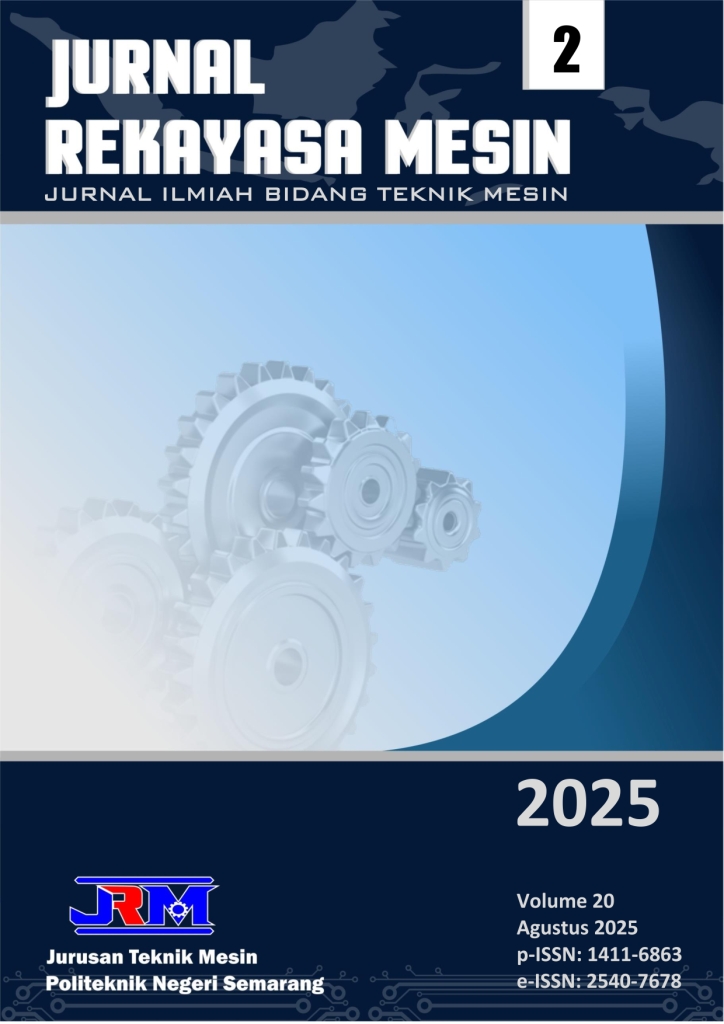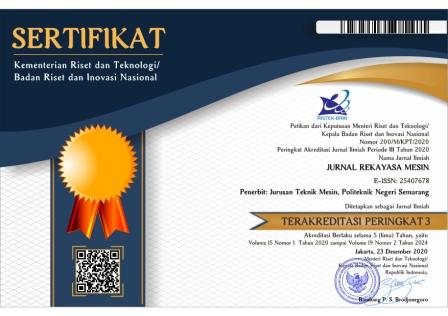The Effect of Coal and Sawdust Co-Firing on Boiler Efficiency with the Direct and Indirect Calculation Methods at PT PLN Nusantara Power Unit 2
DOI:
https://doi.org/10.32497/jrm.v20i2.6548Keywords:
Sawdust, Cofiring, Coal, Direct, Indirect, boiler, EfficiencyAbstract
The increasing demand for electricity in Indonesia has led to a rise in fossil fuel consumption, resulting in negative environmental impacts. As part of its commitment to achieving net zero emissions by 2060, the Indonesian government has begun promoting the application of co-firing technology that utilizes biomass as an alternative fuel. One promising type of biomass is sawdust, which can be blended with coal in the combustion process. This study aims to analyze the effect of sawdust blending on boiler efficiency using both direct and indirect calculation methods. The results show that a fuel composition of 55% low-rank coal (LRC), 40% medium-rank coal (MRC), and 5% sawdust produces a boiler efficiency of 86.8% using the direct method and 85.2% using the indirect method. Additionally, this blend generates lower emissions compared to a mixture of 80% LRC and 20% MRC. These findings indicate that sawdust, when applied through co-firing technology, contributes to improved combustion efficiency and reduced emissions in coal-fired power plants.
References
[1] R. M. Ariefianto and R. A. Aprilianto, “Peluang Dan Tantangan Menuju Net Zero Emission (NZE) Menggunakan Variable Renewable Energy (VRE) Pada Sistem Ketenagalistrikan Di Indonesia,” J. Paradig., vol. 2, no. 2, pp. 1–13, 2021, [Online]. Available: https://www.researchgate.net/publication/357448042
[2] D. S. Nawawi et al., “Chemical Characteristics of Biomass for Energy,” J. Ilmu Teknol. Kayu Trop., vol. 16, no. 1, pp. 44–51, 2018.
[3] M. F. Ilham and N. Sinaga, “Pengaruh Cofiring Menggunakan Serbuk Gergaji Terhadap Emisi Gas Buang di Pembangkit Listrik Tenaga Uap Batubara,” Rekayasa Energi Manufaktur) J. |, vol. 7, no. 2, pp. 2528–3723, 2022, [Online]. Available: http://doi.org/10.21070/rem.v7i2.1644
[4] A. V. Febriani, F. F. Hanum, and A. Rahayu, “Review : Analisis Potensi dan Tantangan Biomassa Sebagai Bahan Bakar pada PLTU dan PLTBm,” no. April 2024, pp. 1–11, 2024.
[5] I. Aufi, J. Wintoko, and N. A. Masruroh, “Evaluasi pemilihan teknologi Co-firing Biomassa pada PLTU batu bara dengan Metode Analytical Hierarchy Process (Studi Kasus: PLTU XYZ),” Angkasa J. Ilm. Bid. Teknol., vol. 15, no. 1, p. 88, 2023, doi: 10.28989/angkasa.v15i1.1641.
[6] Y. C. Dwiaji, “Analisis Pengaruh Co-Firing Biomassa Terhadap Kinerja Peralatan Boiler PLTU Batubara Unit 1 PT. XYZ,” J. Appl. Mech. Eng. Renew. Energy, vol. 3, no. 1, pp. 7–15, 2023, doi: 10.52158/jamere.v3i1.445.
[7] G. N. Tampubolon and B. A. Dwiyantoro, “Studi Pengaruh Rasio Co-firing Bahan Bakar Batubara dan Biomassa Tertorefaksi Terhadap Performa Boiler,” J. Tek. ITS, vol. 12, no. 3, pp. 3–8, 2023, doi: 10.12962/j23373539.v12i3.128337.
[8] M. F. Ilham and S. W. A. Suedy, “Effect of Cofiring Using Sawdust on Steam Coal Power Plant Heat Rate Value,” J. Energi Baru dan Terbarukan, vol. 3, no. 2, pp. 121–127, 2022, doi: 10.14710/jebt.2022.13828.
[9] W. Sulaiman, Sugiyarto, and E. Mahajoeno, “Biodelignification Of Coconut Wood Sawdust Using Pleuratus Sapidus,” Semin. Nas. Edusainstek FMIPA UNIMUS, pp. 37–45, 2018.
[10] C. L. Chayalakshmi, D. S. Jangamshetti, and S. Sonoli, “Boiler efficiency estimation from hydrogen content in fuel,” 2015 Int. Conf. Adv. Comput. Commun. Informatics, ICACCI 2015, no. April, pp. 1107–1110, 2020, doi: 10.1109/ICACCI.2015.7275758.
[11] F. Tri Putra, Y. I. Basir, and M. . Ir H M Nefo Alamsyah, “Analisa Bahan Bakar Biomassa PLTU Asam-Asan Sebagai Pengganti Bahan Bakar Batubara,” J. Tek. mesin, pp. 1–10, 2019.
[12] D. Putri and K. Umma, “Variasi Rasio Co-Firing Batubara Dan Sawdust ( Serbuk Gergaji ) Terhadap Pembangkit Listrik Tenaga Uap,” vol. 06, no. 01, pp. 28–36, 2025.
[13] K. A. Margawadi, Widayat, and S. W. A. Suedy, “Co-firing simulations with blending of low range coal and medium range coal on the performance of 615 MW capacity steam power plant and Indonesia carbon trading review,” E3S Web Conf., vol. 605, 2025, doi: 10.1051/e3sconf/202560501005.
[14] A. N. Sidiq, “Pengaruh Co-Firing Biomassa terhadap Efisiensi Boiler PLTU Batubara,” Kilat, vol. 11, no. 1, pp. 21–31, 2022, doi: 10.33322/kilat.v11i1.1553.
[15] Z. Arifin, V. F. S. Insani, M. Idris, K. R. Hadiyati, Z. Anugia, and D. Irianto, “Techno-Economic Analysis of Co-firing for Pulverized Coal Boilers Power Plant in Indonesia,” Int. J. Renew. Energy Dev., vol. 12, no. 2, pp. 261–269, 2023, doi: 10.14710/ijred.2023.48102.
[16] E. Gultom, D. Angga, F. Muzhoffar, and E. Ari, “Pengaruh Cofiring Menggunakan Variasi Biomassa untuk Menjaga Feedstock Biomassa di Pembangkit Listrik Tenaga Uap Batubara,” vol. 9, no. 2, 2024.
[17] R. F. Meditama, I. M. Fitriani, and F. K. Asshidiqi, “G-Tech : Jurnal Teknologi Terapan Analysis of Heat Rate Co-firing Pacitan PLTU,” vol. 9, no. 1, pp. 410–416, 2025.
[18] F. Tanbar et al., “Analisa Karakteristik Pengujian Co-Firing Biomassa Sawdust Pada Pltu Type Pulverized Coal Boiler Sebagai Upaya Bauran Renewable Energy,” J. Offshore, vol. 5, no. 2, pp. 2549–8681, 2021.
Downloads
Published
How to Cite
Issue
Section
License
Copyright (c) 2025 Radissa Dzaky Issafira, Muhammad Daru Fatkhur Rizki, Mokh Ausin Al Qoroni, Vrischo Candra Kumara Wardana

This work is licensed under a Creative Commons Attribution-NonCommercial-ShareAlike 4.0 International License.
Copyright of articles that appear in Jurnal Rekayasa Mesin belongs exclusively to Penerbit Jurusan Teknik Mesin Politeknik Negeri Semarang. This copyright covers the rights to reproduce the article, including reprints, electronic reproductions, or any other reproductions of similar nature.







